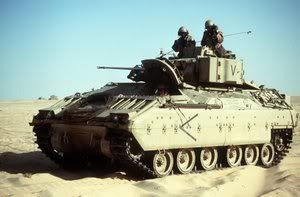LeEnfield
Active member
Warrior Infantry Fighting Vehicle

The Warrior Infantry Fighting Vehicle has the speed and performance to keep up with Challenger 2 Main Battle Tanks over the most difficult terrain, and the firepower and armour to support infantry in the assault.
The Warrior (WR) family of 7 variants of armoured vehicles entered service in 1988 and have proved a resounding success for Armoured Infantry (AI) battlegroups (BG) in the Gulf War, Bosnia and Kosovo and Iraq. They provide excellent mobility, lethality and survivability for the Infantry and have enabled key elements from the Royal Artillery and Royal Electrical and Mechanical Engineers to operate effectively within the Battle Group. A highly successful armoured fighting vehicle, Warrior can be fitted with Enhanced Armour and is continuously being updated; for example, the Battle-group Thermal Imager (BTI) is being fitted to increase its night-fighting capability.

Warrior Infantry Fighting Vehicle
Warrior infantry command and section vehicles carry a turret mounted 30 mm Rarden cannon that will defeat light armoured vehicles out to 1,500 m. An 8x magnification image-intensifying night sight is fitted, and eight light anti-armour weapons (LAW) can be stowed in the vehicle.
Warrior variants include artillery observation post vehicle (OPV) and command post vehicle (CPV), and a Royal Mechanical and Electrical Engineers (REME) recovery and repair vehicle. All variants are equipped with a 7.62 mm chain gun. Both chain gun and Rarden cannon have an anti-helicopter capability.
The most impressive feature of Warrior is its power. The 550 bhp diesel engine gives a power-to-weight ratio of 23.5 bhp/ton resulting in a road speed of 75 kph and a cross-country speed of up to 50 kph. This is 30% better than the FV432 and with the improved suspension and a lower ground pressure it allows Warrior to keep pace with Challenger 2 across the toughest terrain. Warrior can wade to a depth of 1.3 m.
The armour is designed to withstand an explosion from a 155mm shell at 10 m and direct fire from machine guns up to a caliber of 14.5 mm. During the first Gulf War and Operations in the Balkans and Iraq, additional armoured protection was fitted for additional protection. Collective CBRN protection is provided when closed down and the section should be able to remain fully closed down for 48 hours. A toilet is also provided in the vehicle.

The Warrior Infantry Fighting Vehicle has the speed and performance to keep up with Challenger 2 Main Battle Tanks over the most difficult terrain, and the firepower and armour to support infantry in the assault.
The Warrior (WR) family of 7 variants of armoured vehicles entered service in 1988 and have proved a resounding success for Armoured Infantry (AI) battlegroups (BG) in the Gulf War, Bosnia and Kosovo and Iraq. They provide excellent mobility, lethality and survivability for the Infantry and have enabled key elements from the Royal Artillery and Royal Electrical and Mechanical Engineers to operate effectively within the Battle Group. A highly successful armoured fighting vehicle, Warrior can be fitted with Enhanced Armour and is continuously being updated; for example, the Battle-group Thermal Imager (BTI) is being fitted to increase its night-fighting capability.

Warrior Infantry Fighting Vehicle
Warrior infantry command and section vehicles carry a turret mounted 30 mm Rarden cannon that will defeat light armoured vehicles out to 1,500 m. An 8x magnification image-intensifying night sight is fitted, and eight light anti-armour weapons (LAW) can be stowed in the vehicle.
Warrior variants include artillery observation post vehicle (OPV) and command post vehicle (CPV), and a Royal Mechanical and Electrical Engineers (REME) recovery and repair vehicle. All variants are equipped with a 7.62 mm chain gun. Both chain gun and Rarden cannon have an anti-helicopter capability.
The most impressive feature of Warrior is its power. The 550 bhp diesel engine gives a power-to-weight ratio of 23.5 bhp/ton resulting in a road speed of 75 kph and a cross-country speed of up to 50 kph. This is 30% better than the FV432 and with the improved suspension and a lower ground pressure it allows Warrior to keep pace with Challenger 2 across the toughest terrain. Warrior can wade to a depth of 1.3 m.
The armour is designed to withstand an explosion from a 155mm shell at 10 m and direct fire from machine guns up to a caliber of 14.5 mm. During the first Gulf War and Operations in the Balkans and Iraq, additional armoured protection was fitted for additional protection. Collective CBRN protection is provided when closed down and the section should be able to remain fully closed down for 48 hours. A toilet is also provided in the vehicle.





